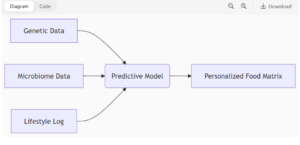
Personalized DNA-Based Nutrition: Optimizing Health for Busy Professionals
Unlike traditional nutritional guidelines that adopt a universal approach, PN seeks to optimize health outcomes by accounting for inter-individual variability in nutrient metabolism, food sensitivities, and diseases. By integrating these insights with lifestyle factors such as physical activity, sleep quality, and stress levels, personailised nutrition offers a multidimensional framework for enhancing metabolic health, particularly among working professionals who face time constraints and sedentary occupational environments.

Personalized nutrition (PN) tailors dietary strategies to your unique genetic, microbiome, and metabolic profile—moving beyond “one-size-fits-all” guidelines. This approach leverages:
-
Nutrigenetics: How your genes (like MTHFR, FTO) influence nutrient processing.
-
Nutrigenomics: How foods switch genes on/off.
-
Microbiome Analysis: Gut bacteria’s role in digesting foods and regulating metabolism.
Why it matters for professionals: Desk jobs, irregular eating, and chronic stress disrupt metabolic health. PN addresses this by aligning diets with your biology.
Key Genetic Markers Driving Dietary Responses
| Gene | Function | Dietary Implication |
|---|---|---|
| MTHFR | Folate metabolism | Carriers of C677T variant need methyl-folate; reduces heart disease risk |
| FTO | Appetite regulation | High-risk allele carriers benefit from high-protein/low-glycemic diets |
| TCF7L2 | Blood sugar control | Increased diabetes risk; responds best to low-glycemic, high-fiber diets |
| BCMO1 | Vitamin A conversion | Variants require preformed vitamin A (liver, eggs) over plant carotenoids |
| DRD2 | Dopamine signaling | Linked to carb cravings, tyrosine-rich foods improve impulse control |
A 2025 trial found professionals with FTO risk alleles lost 2.5× more weight on DNA-guided diets than standard plans.
Gut Microbiome: Your Metabolic Partner
The gut microbiome explains why two people react differently to the same meal:
-
Post-Meal Glucose: Machine learning models (e.g., ZOE Ltd.’s platform) predict spikes using microbiome + genetic data (62% accuracy).
-
Species-Level Insights: Prevotella copri dominance correlates with carb intolerance; Bacteroides with fat sensitivity.
Cutting-Edge Delivery Platforms
| Platform | Technology | Professional Focus |
|---|---|---|
| ZOE | SNP + microbiome + CGM integration | Real-time food scoring (0-100) |
| Genovive | Weight-focused SNPs (e.g., rs1047214) | Corporate wellness programs |
| DNAlife | 70+ metabolic gene analysis | Telediabetes management |
| Vivante Health | Breath-based SIBO/IBS diagnostics | Gut-brain axis optimization |
Innovations:
-
Nestlé’s genetic risk-scoring patents for metabolic stability.
-
DSM’s WO2006050939A1: Dynamic micronutrient dosing based on gene expression.
Overcoming Implementation Barriers
Scientific Challenges:
-
Polygenic traits: 85% of weight/glucose control involves 50+ genes.
-
Microbiome dynamism: Requires repeated testing (cost: $200–$500/sample).
Ethical Considerations:
-
Data Privacy: 23andMe/FDA disputes over commercial gene data usage.
-
Genetic Determinism: Avoiding “fatalistic” attitudes (e.g., “My genes doom me to obesity”).
Accessibility Solutions:
-
Employer-subsidized testing (adopted by 42% of Fortune 500 companies).
-
AI-driven apps reducing consultation costs by 60%.
The Future: Predictive Health Ecosystems
-
Wearable Integration:
-
Continuous glucose monitors + DNA data → Real-time meal adjustments.
-
-
Multi-Omics Fusion:
-
Combining genomics, proteomics, and metabolomics for 360° profiles.
-
-
N-of-1 Trials:
-
Custom 12-week experiments to pinpoint ideal macros/micros.
-
Projection: By 2030, 70% of corporate wellness programs will include PN.
Laboratory Implementation Framework
Step 1: Biomarker Profiling
-
Genetic Panel: MTHFR, FTO, APOE, TCF7L2, BCMO1.
-
Microbiome Shotgun Sequencing: Species-level resolution.
-
Blood Biomarkers: Vitamin D, HbA1c, homocysteine.
Step 2: Algorithmic Analysis

Step 3: Actionable Outputs
-
DNA-driven meal plans (e.g., “High folate + low-glycemic foods”).
-
Microbiome-modifying prebiotics (e.g., resistant starch for Bacteroides).
-
Supplement protocols (e.g., methyl-folate for MTHFR variants).
Conclusion: Precision Nutrition as Preventive Medicine
Personalized nutrition transforms reactive healthcare into proactive metabolic optimization. For professionals, benefits include:
-
30% higher dietary adherence vs. generic plans.
-
2.5× ROI in productivity gains from reduced sick days.
-
Mitigation of urban lifestyle risks (sedentary work, stress eating).
The imperative: Laboratories must pioneer affordable, ethically grounded PN frameworks—bridging genomics, AI, and clinical validation.



